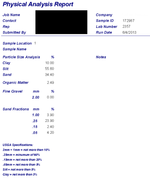Following the instructions from this article
http://aroundtheyard.com/home1/articles ... ement.html, I pulled a couple of 4" cores from my water-repellant back yard. A picture of what it looks like after 2 days is attached (ignore the green marks--squiggly purple is correct in this case).

So Andy, will you take that $5 as an additional donation to the site?

I know that this is not definitive and now, more than ever, I want to include a soil analysis request when I send in my sample to Logan Labs in the spring. On the other hand, I am gobsmacked to see such a small percentage of clay in my sample. Surely, I must have screwed up something, right? How can I have so much sand/gravel and silt and have such impermeable soil? Does silt compact this much?


I know that nothing can nor should be done about it now, and will of course wait for the 3+ year plan that the site experts recommend after I post my results from Logan next year, but if anyone has any comments just to settle my curiosity and confusion, I would appreciate it. Thanks.

